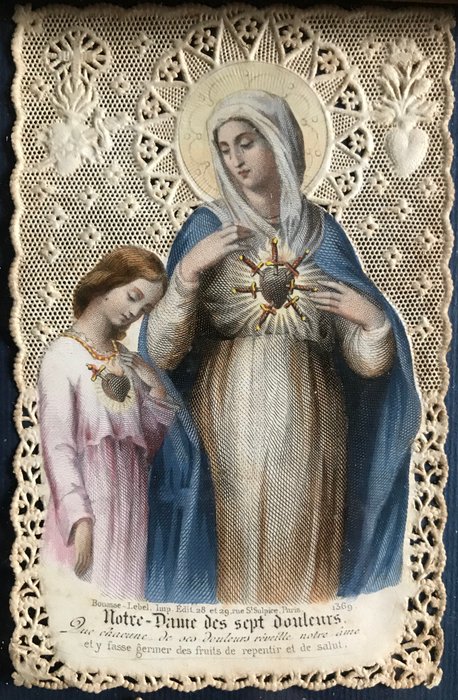Liturgical imagery must rise above both the saccharine, porcelain-doll portraits of the 19th
century holy cards and the hyper-realistic and overly optimistic
imagery of Christ as a chummy first century Mediterranean blessing our
children [and hugging us on judgment day] ….Dennis McNamara, p. 75, Catholic Church Architecture and the Spirit of the Liturgy.
Bingo. The art of the Church, whether permanent in painting or statuary or temporary in print, has too often been victim of extremes. A couple of hundred years ago we surrendered reality to an idealized portraiture of Jesus and the saints, what McNamara calls the porcelain-doll imagery that distanced the things of God from people and their everyday lives. Now we live in the opposite extreme. We like the images of the laughing Jesus or the smiling Christ who is not so much God in flesh as your buddy, even your best buddy. But both extremes offer the same problem. Jesus is not very threatening in either picture -- not the idealized (feminized) porcelain doll image or the chummy Jesus who sits with us on our couches and throws back a couple of brewskis. And that is the goal of such art -- to remove anything threatening from Jesus and to make Him out to be fragile on one side or just one of the guys on the other.
Strangely, we seem to prefer a God who commiserates with us rather than a God who can do something about that misery or a God who may not have much to offer in terms of hope but neither does He threaten us any with holiness, judgment, or power. We have done a fairly good job of emasculating Jesus in the past and making Him untouchable. But we have also done a credible job today of making Jesus less God and more friend, making Him touchable but no more powerful than we are to effect any change or transformation in us or our lives.
I grew up with an idealized picture of Jesus, blondish brown hair, Scandinavian characteristics, tall and lanky, in His white robe. Perhaps it is a good thing for us to see Jesus with our own racial or ethnic identities but it is not a bad thing to have an idealized Jesus, almost feminized Lord, who is like grandmother's fragile glass figurines that dare not be touched. Such a Jesus not only observes from afar but is observed from afar. My grandchildren will be tempted by images of Jesus in which His ethnic characteristics are more prominent but He just may be wearing a team jersey, holding a craft beer in his hand, and alternately laughing or cursing a blue streak. I am not sure which is more dangerous -- a distant God who may be powerful but who would not want to get His hands dirty or a God who gets His hands dirty but is not powerful. In any case, Satan has worked even in imagery to keep us from the honest portrait of our Lord in Scripture.
Ours is a God who bleeds and hurts but who bleeds and hurts for us. He is not some weak deity who leaves the heavy lifting to others but who takes upon Himself every great weight and burden we cannot bear. He is not some plastic or porcelain God who is fragile and must be protected from our sins but the God who knows our sin better than we know them and who is determined to be scarred by them even to death upon a cross. He is not some God who watches everything from a heavenly box seat but the God with us, Emmanuel, even in the earthy elements of water, bread, and wine.
Liturgy can do the same thing. It can make Jesus inaccessible and fragile or it can make Jesus so immanent that the things eternal are neither spoken of nor acknowledged. The Latin Mass surely emphasized this holy God, somewhat distant to us, but the Novus Ordo gives us the opposite picture of God and the Church. Yet if I had to choose, I would rather have a powerful God who may appear distant instead of a God who is near but impotent to answer my need. Hymnody has also fallen victim of both extremes. On the one hand, it has sung of God and the things of God in idealized and distant terms. On the other it has forgotten the transcendent at all and made it appear Jesus' primary role was to inspire us, encourage us, and cheer us on to achieve our goals. So in the arts and music we must tread carefully. The reality that we know from Scripture is infinitely better than our idealized Lord or our casual buddy.


Excellent post. I balk at pictures that show Christ with His head tilted to one side. Icons in the Eastern Church dispense with all that. The icon of Christ Pantocrator says it all for me. There is the merciful side and the justice side represented and the sense of mystery included which reminds us that He is Mercy and Justice.
ReplyDelete